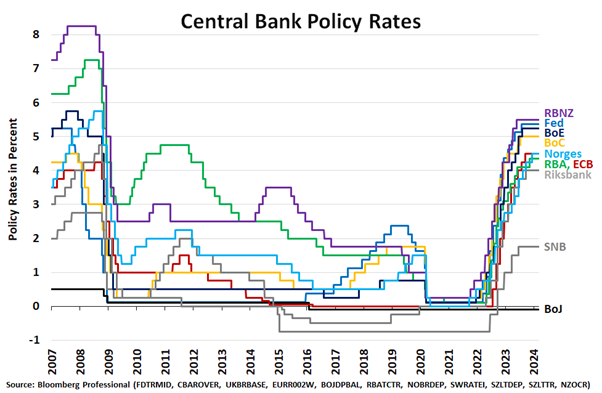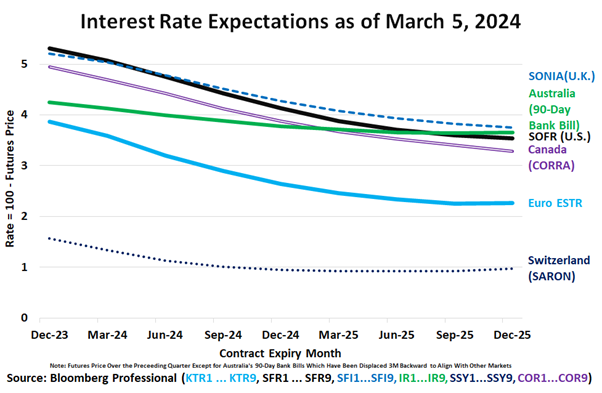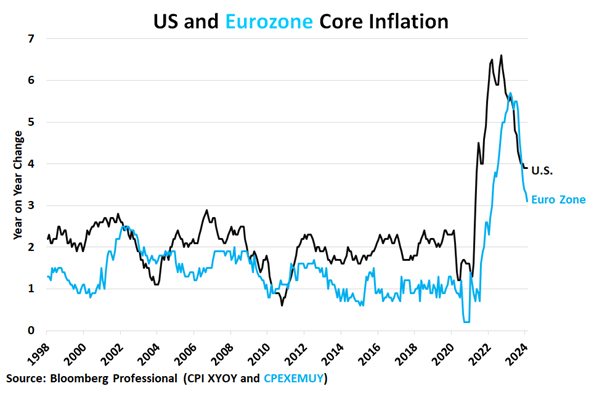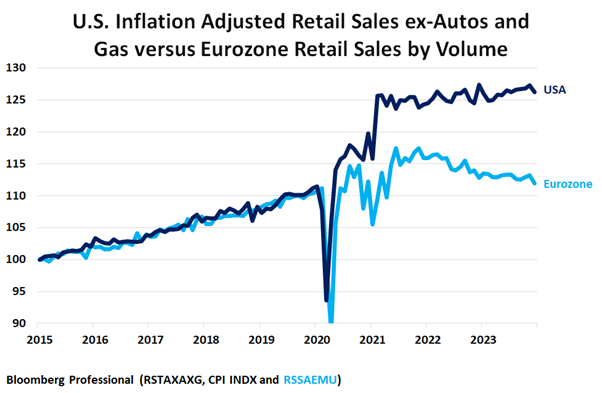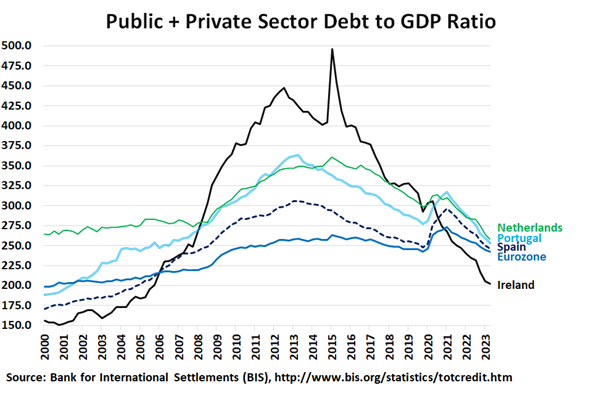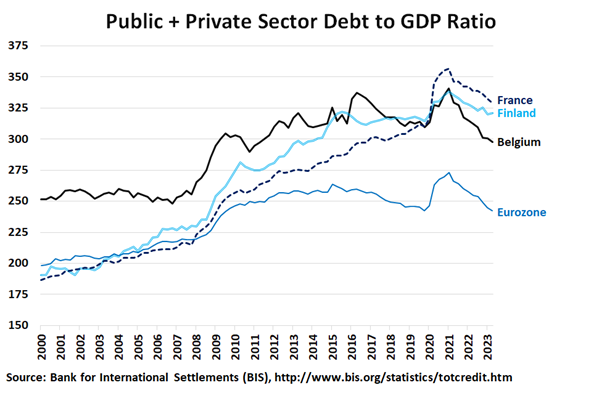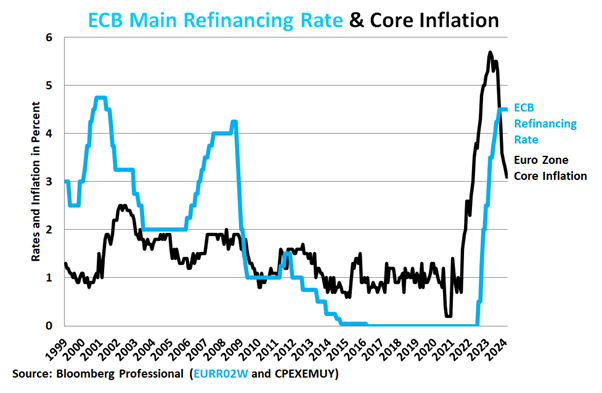ESTR futures expect ECB to cut rates on par with Fed

All examples in this report are hypothetical interpretations of situations and are used for explanation purposes only. The views in this report reflect solely those of the author and not necessarily those of CME Group or its affiliated institutions. This report and the information herein should not be considered investment advice or the results of actual market experience.
By Erik Norland, chief economist and managing director, CME Group
The past two years have witnessed the biggest global monetary policy tightening since 1981, and the European Central Bank’s (ECB) 400 basis points (bps) of rate hikes were in the middle of the range (Figure 1). Investors see the global trend toward higher policy rates to battle inflation reversing later this year with rate cuts coming from nearly every central bank that tightened in 2022 and 2023 (Figure 2). What’s curious is that both CME Group euro short term rate (ESTR) futures and CME Group secured overnight financing rate (SOFR) futures are pricing roughly the same pace of cuts by both the ECB and Federal Reserve (Fed) despite rather different trajectories for inflation and economic growth between the Eurozone and the US. Both ESTR and SOFR futures are pricing about 175 bps of rate cuts between now and late 2025.
Figure 1: Central banks conducted the biggest tightening since 1981
Economic data suggest that of the two central banks, perhaps the ECB might ease policy before the Fed. While Eurozone core inflation peaked later than US core consumer price index (CPI), it has been falling much more rapidly in recent months (Figure 3).
Figure 2: Euro ESTR futures price about 175bps of rate cuts, similar to SOFR futures
Figure 3: Eurozone inflation has been falling more rapidly than US inflation
The overall state of the Eurozone economy is also much weaker than that of the US In 2023, Eurozone gross domestic product (GDP) expanded by 0.1% while US GDP expanded by 3.1%. Nearly one trillion dollars of government spending from the Inflation Reduction Act and Chips and Science Act appears to be supporting US growth while Europe has had no such post-pandemic fiscal stimulus. In fact, many European countries are trimming budgets, including France, which lobbed €10 billion (£8.5bn) off its projected spending earlier this month.
The gap is also reflected in consumer spending numbers, where inflation-adjusted US retail sales have been slowly climbing after their pandemic stimulus-induced surge. By contrast, the pandemic stimulus was much smaller in the Eurozone, and European retail sales have been on a steady decline since 2021 (Figure 4).
Figure 4: Eurozone consumer spending has underperformed that of the US
The unique nature of the Eurozone’s debt market could also put the ECB on the path towards faster policy cuts than the Fed. Compared to Europe, the US debt market is relatively simple: the US has one sovereign issuer emitting debt into currency that is created by its central bank. By contrast, there are currently 20 countries issuing euro denominated debt and each of them have only one vote when it comes to ECB policy. In the early 2010s, Greece, Portugal, Ireland, Spain and Cyprus required bailouts. Italy came perilously close to default.
Since the early 2020s, some countries, including Ireland, Portugal and Spain have massively deleveraged their economies (Figure 5). The same is true of Greece, which is currently experiencing strong growth. By contrast, other Eurozone countries, most notably France, used the long period of zero or negative rates to leverage up their economies (Figure 6). High levels of leverage pose little problem when rates are near zero. However, when rates jump by 400 bps, the risk of private and public sector defaults begins to rise.
When the ECB hiked rates from 2005 to 2008, it took until 2009 for the Eurozone debt crisis to begin. This time, the ECB’s tightening cycle has been both larger and more rapid than the previous one (Figure 7). While European bond spreads remain well behaved for the moment, it is difficult to imagine that such a large and rapid tightening of monetary policy will be entirely without consequence for Europe’s more heavily indebt governments and private sector entities.
More rapidly falling inflation, weaker economic growth and the nature of the Eurozone debt market all point in the direction of the potential for faster and deeper cuts on the part of the ECB than the Fed. That said, the ECB often follows the Fed’s lead rather than act proactively on its own. That view, anyway, seems to be the current position of CME Group ESTR futures, which price more-or-less the same scenario for the ECB as SOFR futures price for the Fed.
Figure 5: Some Eurozone countries used the zero rate period of deleverage
Figure 6: France has gone from below to much above average debt levels
Figure 7: The ECB’s current tightening dwarfs the 2005-08 cycle which triggered a crisis
Found this useful?
Take a complimentary trial of the FOW Marketing Intelligence Platform – the comprehensive source of news and analysis across the buy- and sell- side.
Gain access to:
- A single source of in-depth news, insight and analysis across Asset Management, Securities Finance, Custody, Fund Services and Derivatives
- Our interactive database, optimized to enable you to summarise data and build graphs outlining market activity
- Exclusive whitepapers, supplements and industry analysis curated and published by Futures & Options World
- Breaking news, daily and weekly alerts on the markets most relevant to you

